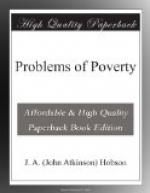Sec. 4. Prices for the Poor.—These figures relating to money income do not bring home to us the evil of poverty. It is not enough to know what the weekly earnings of a poor family are, we must inquire what they can buy with them. Among the city poor, the evil of low wages is intensified by high prices. In general, the poorer the family the higher the prices it must pay for the necessaries of life. Rent is naturally the first item in the poor man’s budget. Here it is evident that the poor pay in proportion to their poverty. The average rent in many large districts of East London is 4s. for one room, 7s. for two. In the crowded parts of Central London the figures stand still higher; 6s. is said to be a moderate price for a single room.[6] Mr. Marchant Williams, an Inspector of Schools for the London School Board, finds that 86 per cent. of the dwellers in certain poor districts of London pay more than one-fifth of their income in rent; 46 per cent. paying from one-half to one-quarter; 42 per cent. paying from one-quarter to one-fifth; and only 12 per cent. paying less than one-fifth of their weekly wage.[7] The poor from their circumstances cannot pay wholesale prices for their shelter, but must buy at high retail prices by the week; they are forced to live near their work (workmen’s trains are for the aristocracy of labour), and thus compete keenly for rooms in the centres of industry; more important still, the value of central ground for factories, shops, and ware-houses raises to famine price the habitable premises. It is notorious that overcrowded, insanitary “slum” property is the most paying form of house property to its owners. The part played by rent in the problems of poverty can scarcely be over-estimated. Attempts to mitigate the evil by erecting model dwellings have scarcely touched the lower classes of wage-earners. The labourer prefers a room in a small house to an intrinsically better accommodation in a barrack-like building. Other than pecuniary motives enter in. The “touchiness of the lower class” causes them to be offended by the very sanitary regulations designed for their benefit.
But “shelter” is not the only thing for which the poor pay high. Astounding facts are adduced as to the prices paid by the poor for common articles of consumption, especially for vegetables, dairy produce, groceries, and coal. The price of fresh vegetables, such as carrots, parsnips, &c., in East London is not infrequently ten times the price at which the same articles can be purchased wholesale from the growers.[8]
Hence arises the popular cry against the wicked middleman who stands between producer and consumer, and takes the bulk of the profit. There is much want of thought shown in this railing against the iniquities of the middleman. It is true that a large portion of the price paid by the poor goes to the retail distributor, but we should remember that the labour of distribution under present conditions and with existing machinery




